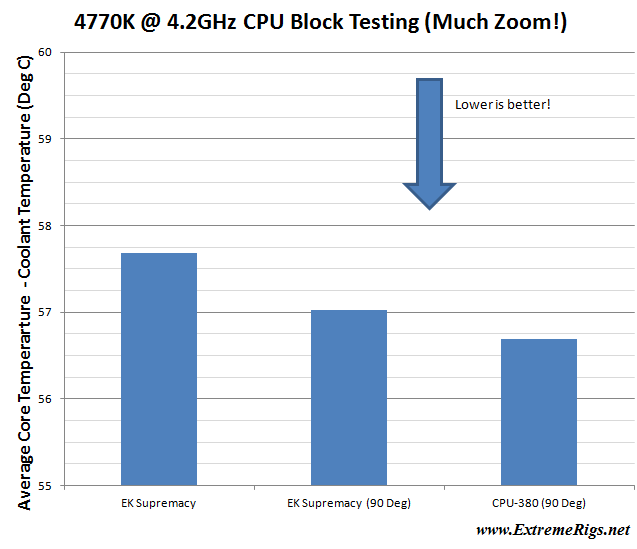While we waited for another 290 to arrive it seemed like a good time to look at CPU blocks on the 4770K. Although we had previously tested blocks on the 3930K during our huge 2012 CPU block roundup we weren’t sure just how well the results would carry over due to the large size difference between the two cpus.
However there were somethings that we expected. Heat was the first. Haswell runs hot thanks to a combination of small die and a poor thermal connection to the IHS from the die. Many people remove the IHS and either cool the die directly, or replace the IHS tim with something better (usually CLU). Although heat was expected, it was impossible to run prime at 4.4GHz just because the part would throttle. The second was how annoying changing blocks on a board that doesn’t have a built in backplate like socket 2011 does.
The test setup was similar to the 2011 roundup. This time we are using the Maximus VI Impact board for testing. The GPU was a 650TI Boost on air and the pump (MCP35x2 again was set to 34% PWM which equates to about 1.3GPM ish. Memory was Corsair Dominator GT 2133CL9 that was ran at a paltry 1333 to keep heat down. Nice and simple. Loading was provided by Prime95 with custom settings, while core temperatures were logged by realtemp. Coolant temperatures were logged by WinTest through the Crystalfontz CF-635 USB using Dallas “one-wire” digital probes. Flow rate was measured by a King Instruments rotameter.
So firstly the question I always get asked after people look at this data is what does a rotation of 90 degrees mean? We consider the logo of the block to be the correct “normal orientation” when it’s horizontal when placed in a normal ATX tower case. This is the EK Supremacy in a “normal” orientation:
While this is the Koolance CPU-380i in a 90 degree rotation:
So as usual we let things stabilize for 40 minutes and then average the next 20 minutes. We repeat 5 runs each with a fresh application of MX2. The results speak for themselves:
Clearly there is a significant difference. Just kidding they are really pretty close. Let’s zoom in:
As in the 3930K testing the CPU-380 has a lead over the EK. However the lead is even smaller on the 4770K because the part itself is pretty low power. Most of the thermal gradient is from the die to the IHS, not from the IHS to the coolant, so even a huge difference in block performance will show little change on cooling of the die. However because the 4770K gets so close to thermal throttling any slight difference in cooling performance can also mean a real difference in what overclock you can hit as an overclock is normally thermally limited before you hit any voltage concerns.
Initially we had planned to do a bunch of repeat block testing on the 4770K. But after seeing this data we may not do more on this 4770K except for the full cover impact block. This is partly because in this small batch results look similar (though scaled down and shifted up) to the 3930K testing, except that errors are now a larger proportion of the block differences. In addition anyone who cares about temps with a decent overclock will want to either delid and run the die naked with the EK naked ivy kit, or delid and apply something like CLU between the die and the IHS. Either of these will make a much larger difference than the choice of cpu block.
Summary
– Intel need to improve haswell/broadwell cooling going forwards
– Koolance CPU-380 at 90 degrees maintains it’s cooling superiority (slightly)
– Delidding should provide the best performance by far















Do you have numbers for the 380 I in regular orientation?
Sorry that was not tested – as the Supremacy showed a mount preference I assumed the preference would be the same on the 380i as it was on the 3930K testing 🙂
Comments are closed.